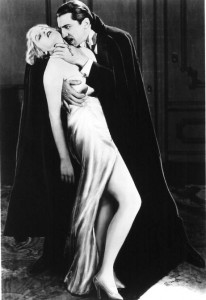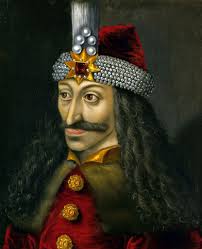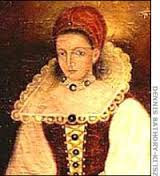I bid you welcome to Mysteries over Martinis! This blog is a mix of unexplained phenomena and personal encounters served up with a mystery-themed cocktail. It’s a recipe for intrigue!
Bloody Countess
Ingredients:
1 part premium vodka
3 parts tomato juice
½ part lemon juice
3 dashes Worcestershire sauce
1 dash hot sauce
1 pinch celery salt
Ground black pepper to taste
Garnish with any combination of the following: bacon strip, dill pickle spear, olives, a celery stalk, cheese cubes or lemon wedge
Add vodka, tomato juice, lemon juice, hot sauce, Worcestershire sauce, ground black pepper and celery salt into a shaker. Shake and pour into a chilled highball glass filled with ice cubes. Impale your favorite garnish victims with a small spear and enjoy the embodiment of life.
Count Dracula: A Peak inside the Coffin
When we think of vampires, most of us visualize the terrifying Count Dracula with his razor sharp fangs and deep widow’s peak. His neck adorned with an ominous black cape which is in stark contrast to his pale skin. Of course, thanks to authors such as Stephanie Myer and Charlaine Harris, today’s younger generation has a much more glamorous idea of the undead. They have created characters who are charming and sexually alluring. But at the core, they are still creatures of the night who feed on the life essence of humans for survival.
Many people are aware that Dracula was the sinister character in Bram Stoker’s dark novel written in 1897. However, not many realize that the concept was based on a Christian crusader infamous for his extreme cruelty. Vlad III Dracula was a 15th century ruler of Wallachia, which is now southern Romania. Dracula was not his original name though. Vlad’s father was a member of a secret society known as the “Order of the Dragon.” He took so much pride in being a member that he changed his name to “Dracul” which is Romanian for “Dragon.” Vlad III became involved in the Order as a child. This prompted him to change his own name to Dracula which translates to “Son of the Dragon.”
Vlad was described as not being very tall but was stocky and strong. He had wide green eyes which were framed by bushy eyebrows that made him appear threatening. During his reign, the Turks were invading Europe from the east. Vlad was determined not to be overtaken and took every measure to ensure the safety of his land. After the Turks tried to advance on Wallachia, Vlad had approximately 20,000 men impaled with spikes and placed them on display along the banks of the Danube River. When the second round of invaders came upon the forest of corpses, it’s said that they retreated in horror. Supposedly, Vlad would dine among his impaled victims. Many of them would live for days moaning in agonizing pain. It’s even believed that Vlad would dip his bread into the blood as it streamed from their bodies. This detail may have just been propaganda though.
Vlad did not only unleash his reign of terror on foreign intruders but he also used barbaric measures as punishment amongst his fellow countrymen. The executions he ordered were carried out in the most heinous manners imaginable. These included beheadings, disembowelment, being boiled or skinned alive but he was most known for impalement. He had it down to an art form by inserting a wooden stake up through the rectum, skewering the torso and then having the end come out the side of the neck. This earned him his grisly moniker of “Vlad the Impaler.”
There are many stories circulating about the extent of his cruelty, but it’s hard to know if it is fact or fiction created to embellish upon his reputation. One story claims that he invited all the poor and homeless in Wallachia for a great feast. During the meal, he left the room and locked all the doors. While his guests drank and ate, he set fire to the entire building in order to do away with what he considered to be nuisances. Another legend is that Dracula was in the presence of foreign emissaries who refused to remove their headgear due to their custom. Vlad then had their hats nailed to their heads. There’s also the story of a high ranking member of Vlad’s government who was asked if the smell of the rotting corpses bothered him. He made the mistake of answering ‘yes.’ Vlad allegedly had him impaled on a longer spike and made a morbid joke about him being above the stench.
Vlad was killed at the hands of his Turkish enemies in 1476. His army was outnumbered so many of the soldiers switched sides. It is said that Dracula’s head was chopped off (possibly by his own troops), sent back to Constantinople and placed atop a wooden spear outside the Sultan’s palace. Reports state that Dracula’s body was then buried at a cemetery in the Snagov Monastery, outside Bucharest. However, there are conflicting reports regarding his remains. Some say his body has never actually been found there, while others say that his body was laid to rest there but has since disappeared. There’s a theory that Vlad didn’t die at the hands of the Turks and was laid to rest elsewhere. There’s the possibility that grave robbers got to it. This seems very plausible considering he was royalty and would have been buried with valuable items. Lastly, there’s the supernatural theory that Dracula has been transformed into a creature of the night.
Vlad the Impaler wasn’t the only historic figure known for unspeakable cruelty and an penchant for blood. Countess Elizabeth Bathory was born into Hungarian nobility in 1560. Ironically, Elizabeth’s ancestor Stephan Bathory had fought alongside Vlad Dracula in an attempt to reclaim the Wallachian throne. Elizabeth’s family was known to hand down harsh justice. She was exposed to extreme violence from a young age. It is theorized that she may have been insane from the time she was a child. She supposedly suffered from seizures which were followed by uncontrollable fits of rage. It’s believed that this contributed to her psychotic behavior.
She married Count Ferenc Nadasdy when she was 15 years old. Ferenc was a soldier who was frequently absent. His family had a reputation for being brutal masters and it’s believed he showed Elizabeth some of his favorite means of punishing servants and those who committed violations. It seems that Elizabeth’s upbringing, sadistic nature and exposure to her husband’s demonstration of torture tactics created one of history’s most notorious serial killers.
It’s reputed that Elizabeth began torturing young servant girls for her own pleasure while her husband was away. She didn’t work alone, she had accomplices which included her children’s wet-nurse, a peasant woman who was allegedly a witch and a manservant who was described as a crippled dwarf. It sounds like the characters from “Snow White,” but this was no fantasy. Elizabeth is said to have recruited young female servants from amongst the lower class. When they were no longer available, she moved on to those of the higher caste system. She beat her maidservants with a barbed lash or a heavy club. Other accounts report that she would have the young ladies dragged naked into the snow and doused with cold water until they froze to death. She is also claimed to have driven spikes into their body and leave them confined in a torture chamber until they met again.
On one occasion, a servant girl accidentally pulled Elizabeth’s hair while she was combing it. Elizabeth retaliated by slapping the girl’s hand so hard she began bleeding. The girl’s blood came in contact with Elizabeth’s hand and the evil countess noticed that the blood made her skin look smoother. Elizabeth had the maid stripped of her clothing. She proceeded to slash her body and drain her blood into a huge vat. Elizabeth, then, bathed in the blood to preserve her youthful beauty. It’s also alleged that she would consume the blood thinking it may act as an antidote to the aging process. It was these atrocities that earned her the name the “Blood Countess.”
Elizabeth continued with her gruesome proclivities until approximately 1610. Up to this point, her body count went largely undetected, or more likely a blind eye was turned to it. It was easy to overlook the disappearance of peasant girls because they would go for long periods of time without communicating with their families. Even if the families suspected something horrible had happened, there wasn’t much that could be done. However, the murder of nobles could not be swept under the rug so easily. Suspicion began to rise as the amount of young noble ladies who went to work for the countess mysteriously vanished. The King of Hungary ordered her arrest. On December 30th of that year, Elizabeth’s cousin, Count Thurzo, lead a night raid on her castle. Thurzo and his soldiers were horrified by the ghastly sights. They stumbled upon the corpse of a young girl who had been drained of her blood. They found one girl who was alive but her body had been pierced with a sharp object. They also discovered several girls who had been imprisoned, awaiting their grisly fate.
Elizabeth’s accomplices were arrested and put on trial but she never was. She was confined to her room where she was walled in. Small openings were made so that she could receive food. She remained a prisoner for four years until she was found dead on the floor in 1614.
As the saying goes, fact is stranger than fiction. It is mind boggling to think that a fictitious character as sinister as Count Dracula was inspired by the cruelty and blood-lust of two historic figures. The chronicles of Vlad Dracula and Countess Elizabeth Bathory may not be completely true, but their horrific reputations lead to the creation of one of the most legendary villains of our time. “There is a reason why all things are as they are.” – Bram Stoker, Dracula
If you’ve had a mysterious encounter you’d like to share, please e-mail me and be sure to like the Mysteries over Martinis Facebook page. Weirdness is always welcome!




Great work here bro do you use WP or BlogEngine?
Thanks so much! I use WP.
Nice Blog, thanks for sharing this kind of information.
I absolutely love your blog.. Very nice colors & theme. Did you make this website yourself? Please reply back as I’m planning to create my own personal website and would love to know where you got this from or exactly what the theme is called. Thank you!